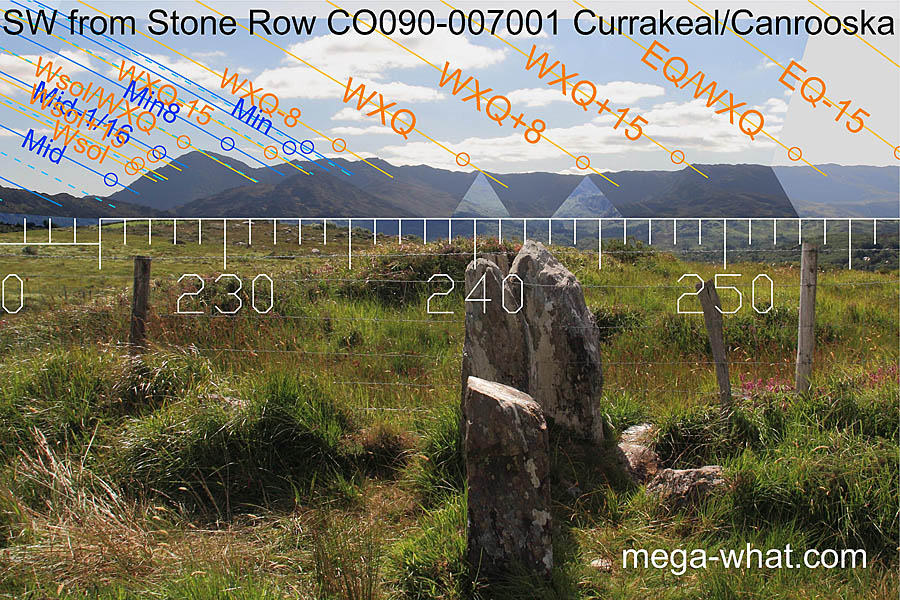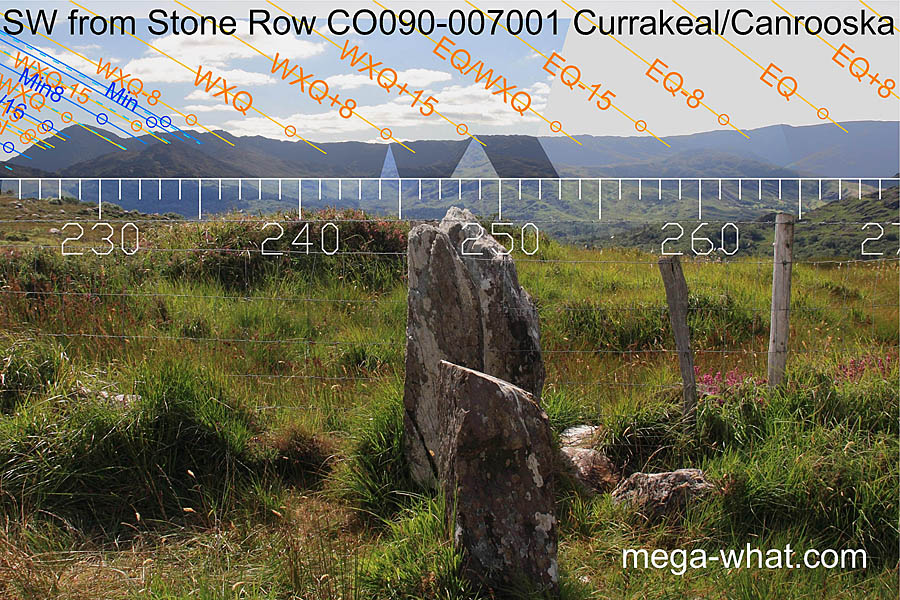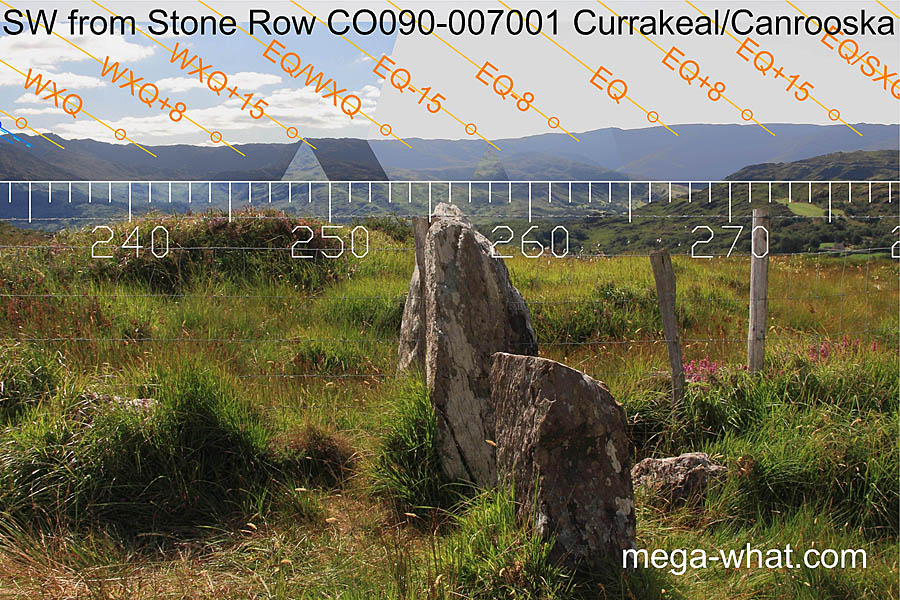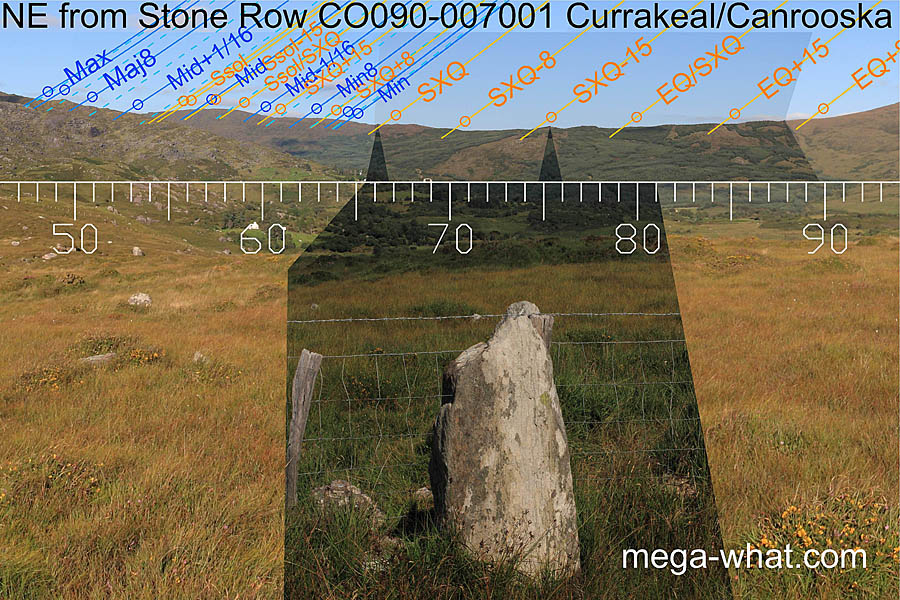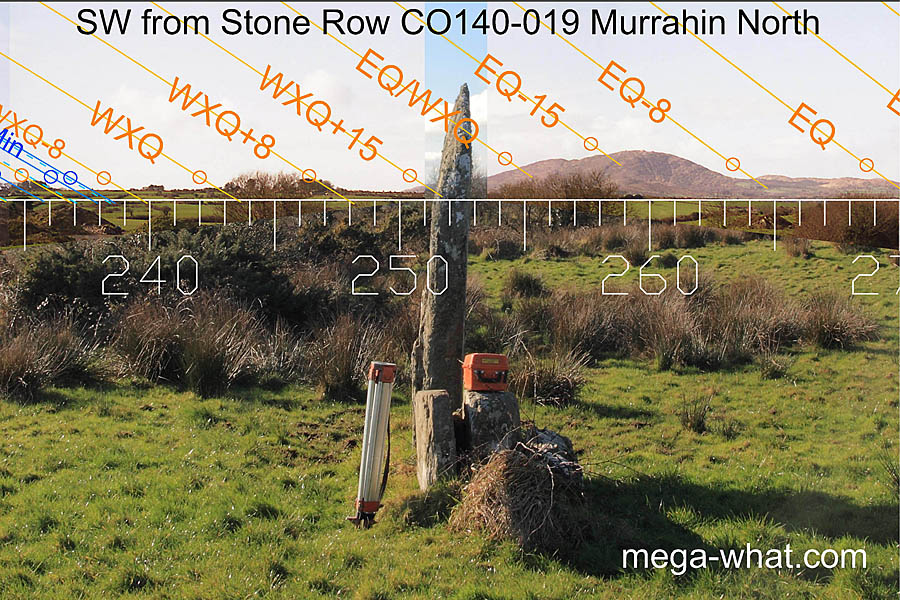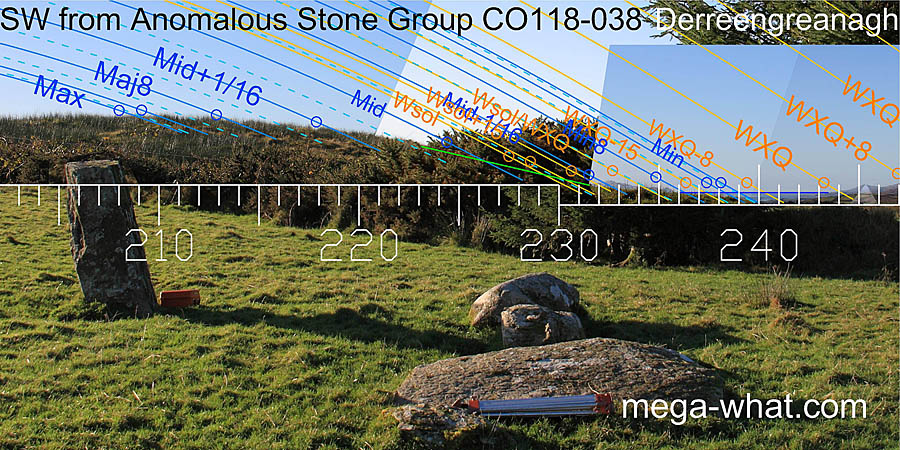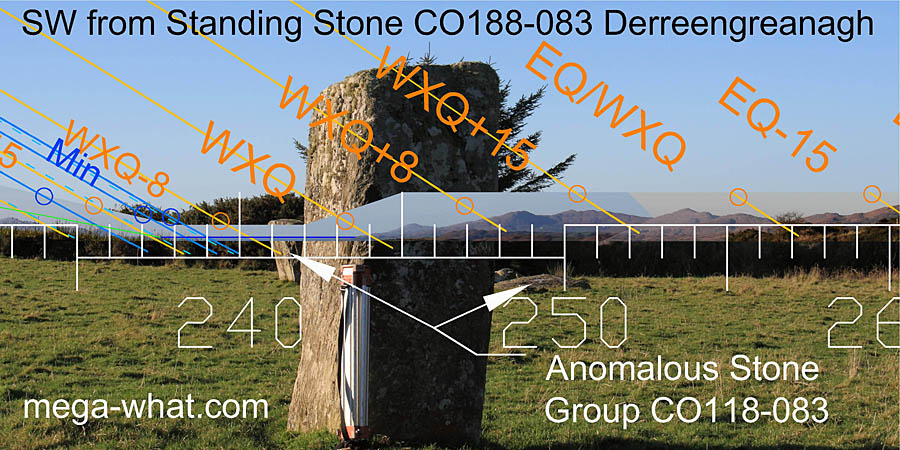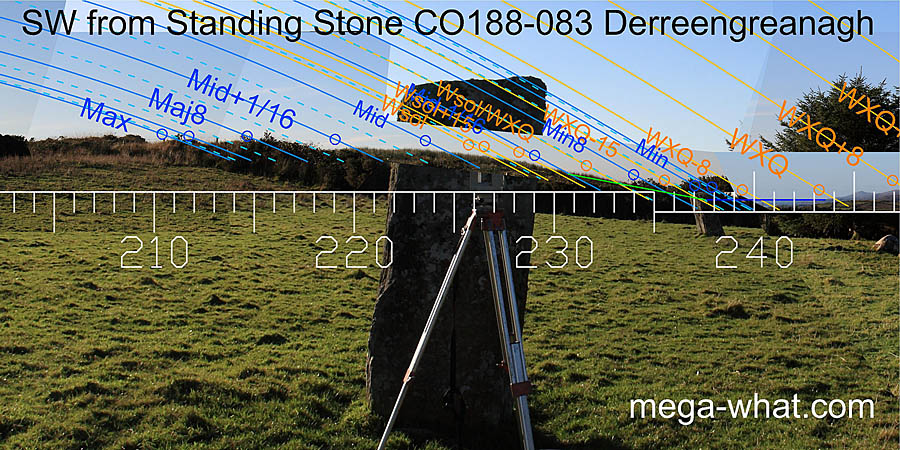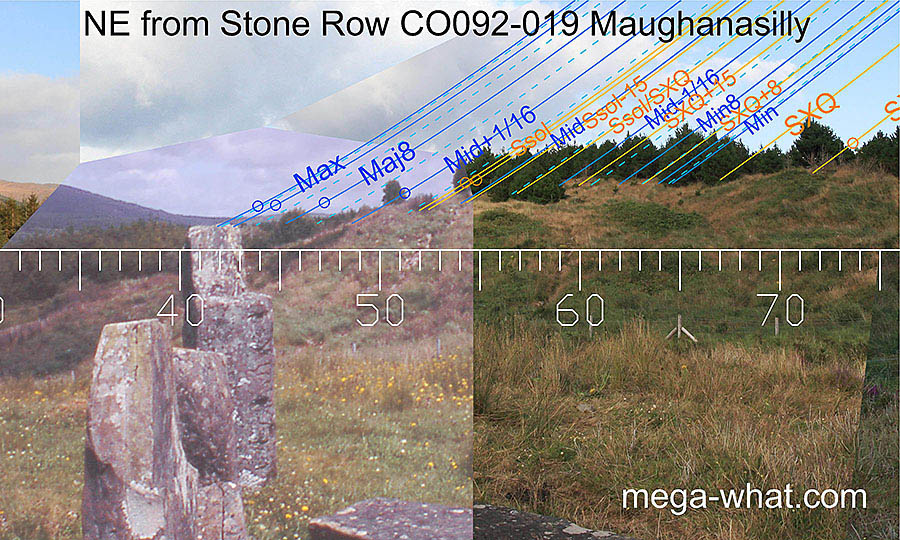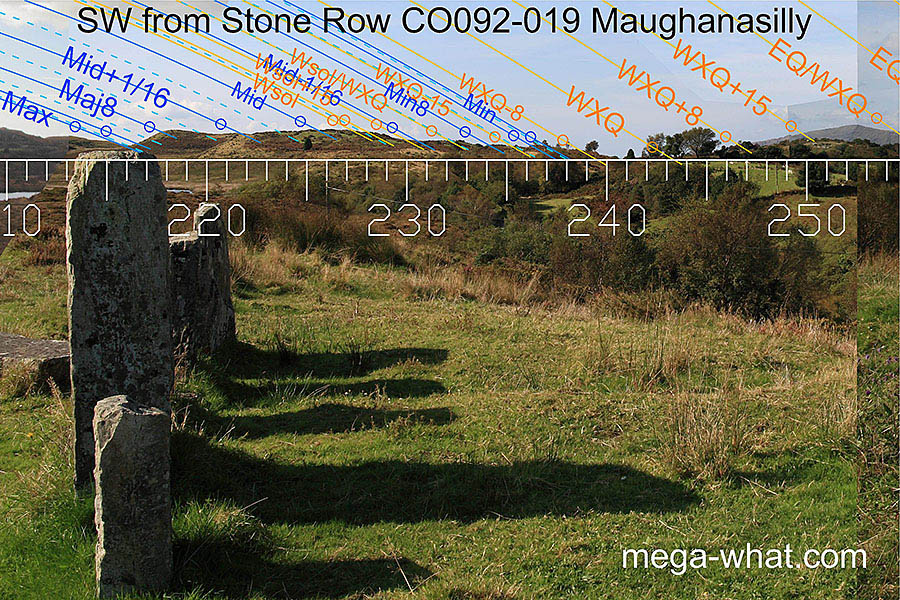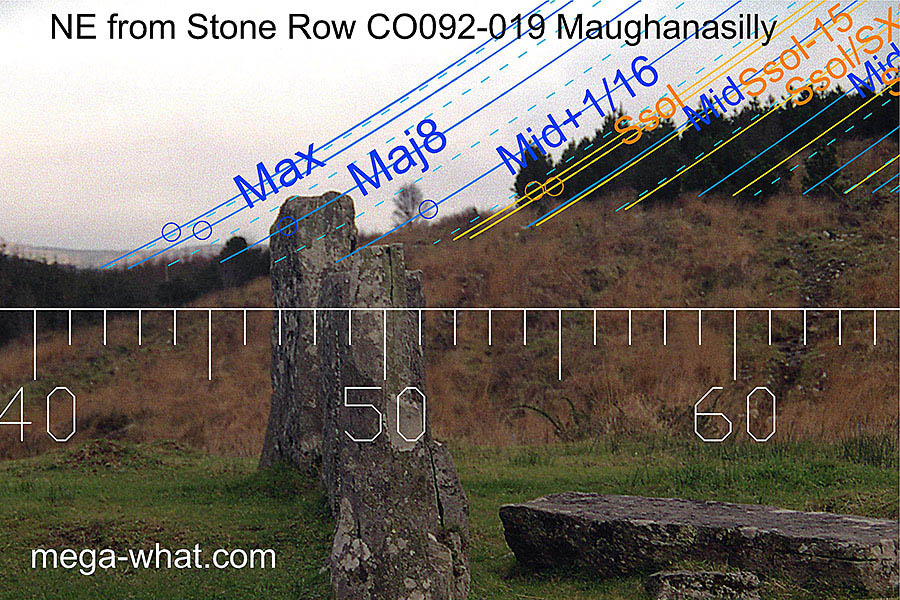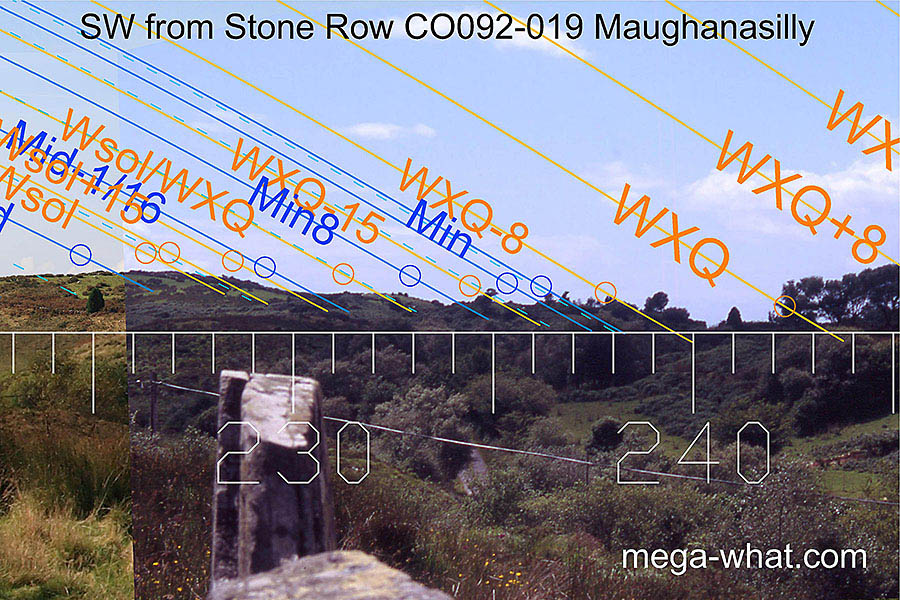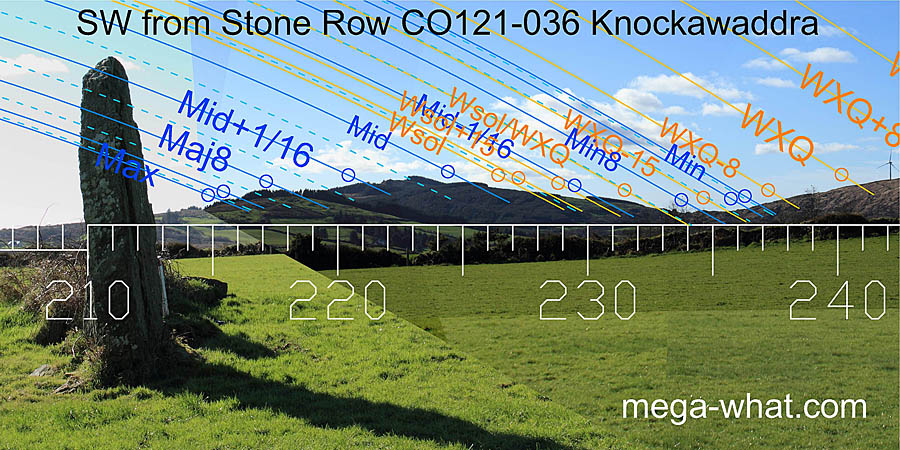Axial alignments of 22 surveyed Stone Rows.
Sorted by: Alignment Class | Location Name
These are all Cork-Kerry type stone rows.
They have from three to six stones all set with their long axes similar to the overall row axis. Three stone ones are easily the most common.
- For classification purposes these surveyed horizons have been divided into a small number of zones.
This classification is an overall one that considers all axes to be potentially bi-directional.
- Extreme is where sun and moon never rise or set but excludes the north-south axis of celestial rotation.
- Lunar is where lunistices
Lunistices are the most northerly and southerly moons of the month. The lunar equivalent of solstices. More.
occur but sun rises or sets do not.
- Solar is where sun rises or sets occur but lunistices do not.
- Solar / Lunar is where a lunistice zone overlaps with the outer regions of the sun's annual travels.
Alternatively one direction may be purely solar while the other is somewhere within a lunistice range.
- Note that these terms may well have other uses elsewhere.
Axial Alignment Classes of surveyed stone rows
| Type | Number | %
|
|---|
| Solar | 5 | 23
|
| Solar / Lunar | 9 | 41
|
| Lunar | 8 | 36
|
| Extreme | - | -
|
| North-South | - | -
|
| All | 22 | 100
|
- This sample is c.25% of known Cork-Kerry type stone rows.
- There are more lunar rows than solar ones in a 3 to 2 ratio.
- The largest portion of all are the ones that point to the zone of solar / lunar overlap but this conservative classification system does not attempt to be more specific about them.
- A previous, more interpretative view given elsewhere classed 51% as lunar and 49% as solar.
Of this sample, eighteen are bi-directional and four are uni-directional.
Note that in the case of uni-directional axes the significant direction may be the apparent reverse.
See for yourself:
- Orange Solar trajectories split the tropical year into 48 "Tweeks" (7.6 day mean) that are better regarded as quarter-months.
- Solid Blue Lunar lines split cyclical lunistice position variation into 16 periods of about 14 months each.
- Lunistices are the most northerly and southerly moons of the month [More].
- Also see Technical Notes on the Pictures
Class = Solar: Total 5 = 23%.
Both axial directions indicate pure solar horizons where no
lunistices
Lunistices are the most northerly and southerly moons of the month. The lunar equivalent of solstices. More.
occur, or one direction does so while the other is beyond the entire luni-solar range.
Go to class= Solar/Lunar |
Lunar

 Canrooska Stone Row
Canrooska Stone Row:
The axis of this stone row is towards the equinox / cross-quarter midpoint in both directions but,
also in both directions, the other side of the row is about a week to the north.
That's before Lughnasadh and Samhain, after Imbolc and Bealtaine. This row is near / related to
Currakeal Stone Row.
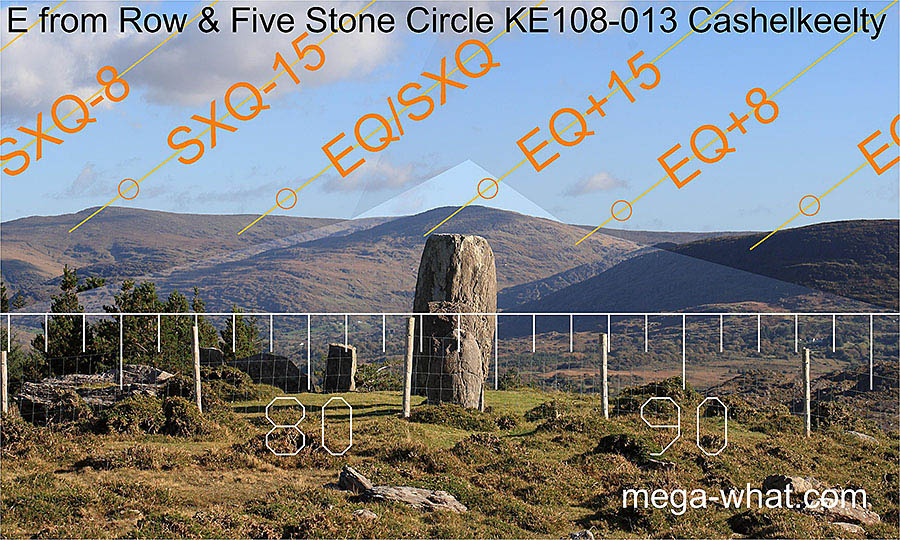
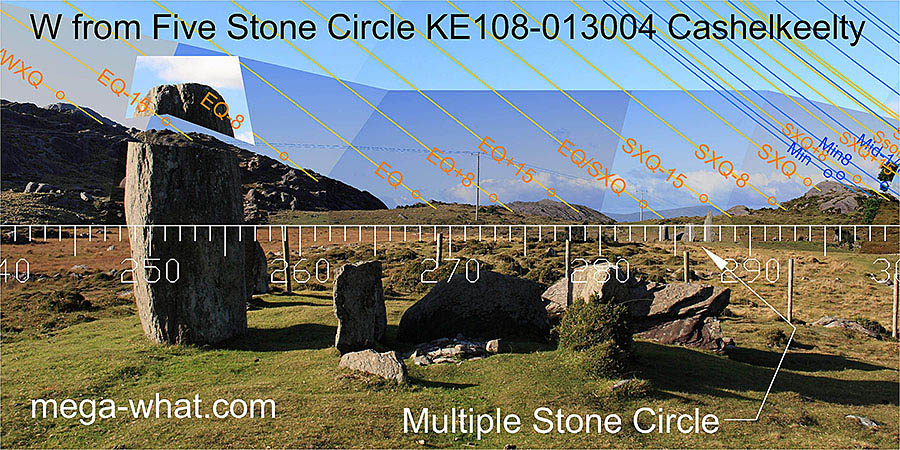 Cashelkeelty Stone Row
Cashelkeelty Stone Row:
Beside a five stone circle and probably built before it. Survey was from the circle.
The row axis is a half-month or so from the equinox in both directions.
The circle axis is harder to determine due to the broken portals but seems to be more equinoctial.
Excavated.
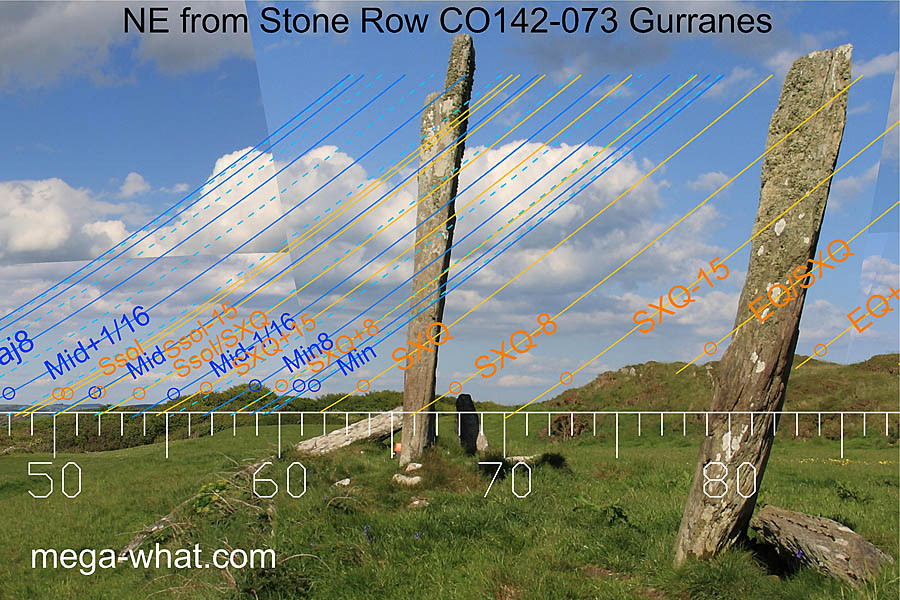
 Gurranes Stone Row
Gurranes Stone Row:
The axis of the two remaining uprights of a four stone row point a little south of the summer cross-quarters and
just north of the winter cross-quarters.
A fifth stone is offset, indicating the equinox / cross-quarter midpoint to the north-east but
just a little more than two weeks north of the cross-quarters to the south-west
[Pic].
Class = Solar / Lunar: Total 9 = 41%.
There are four zones, each roughly 10° wide at these latitudes, where the minor side of a
lunistice
Lunistices are the most northerly and southerly moons of the month. The lunar equivalent of solstices. More.
range overlaps with solar risings or settings.
At least one axial direction indicates one of them. If only one does so then the other may be any class. Alternatively one direction may be purely solar while the other is somewhere within a lunistice range.
Go to class= Solar |
Lunar
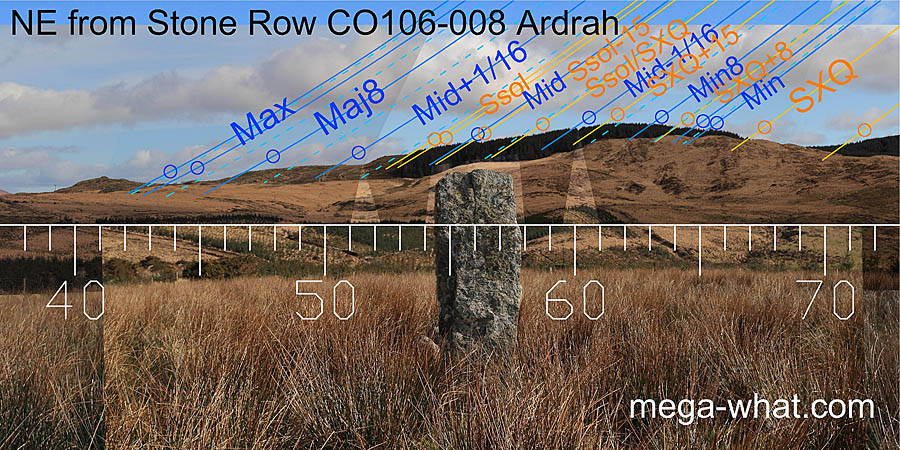
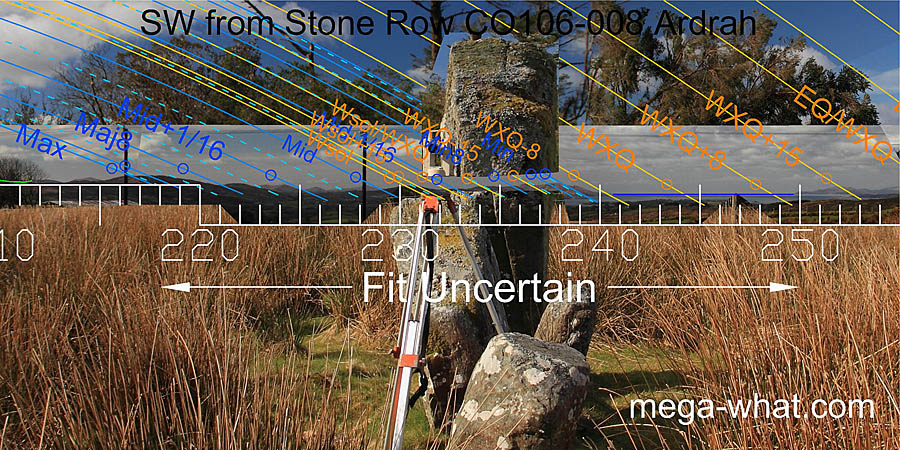 Ardrah Stone Row
Ardrah Stone Row:
Indicates summer solstice / lunar midpoint to the north-east.
The tall south-west stone cuts the horizon and was perhaps intended to have winter solstice to its left and minor standstill to its right.

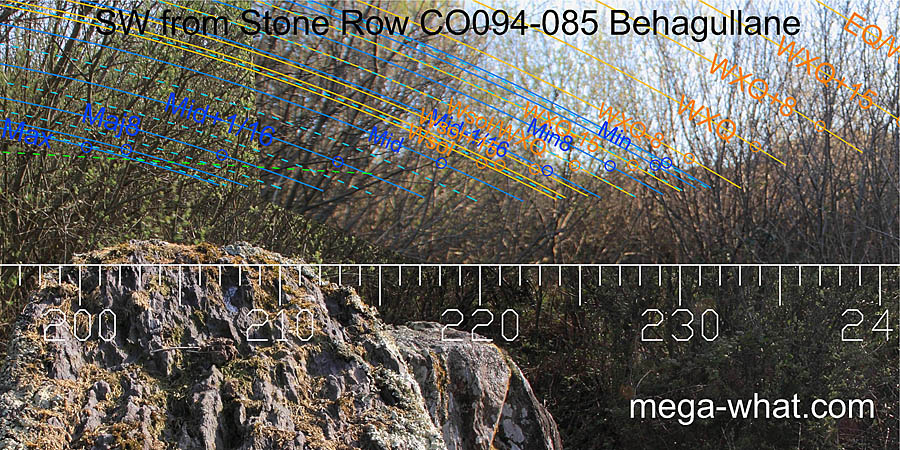 Behagullane Stone Row
Behagullane Stone Row:
The north-east axis is just beyond major standstill and two more stones should be visible in this direction but are now only broken stumps.
The south-west is obscured but the axis is approximately solstitial.
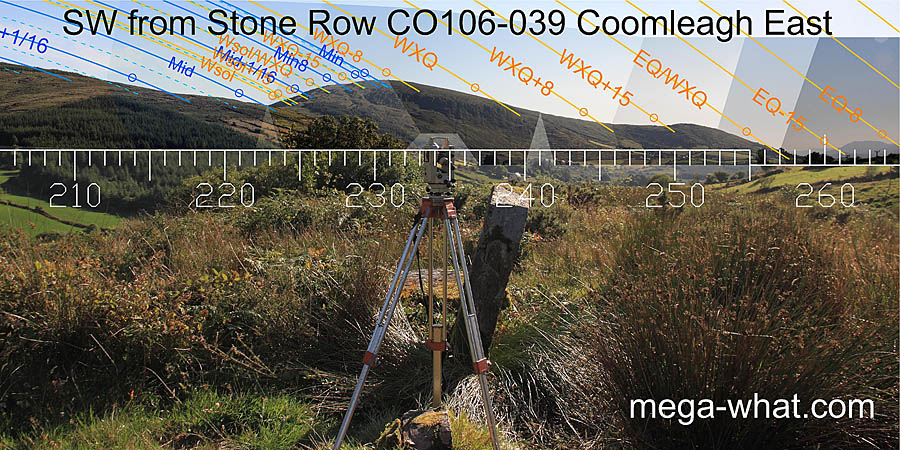
 Coomleagh Stone Row
Coomleagh Stone Row:
The primary south-western axis is towards winter cross-quarters. The reverse is about half-way between summer solstice and the summer cross-quarters.

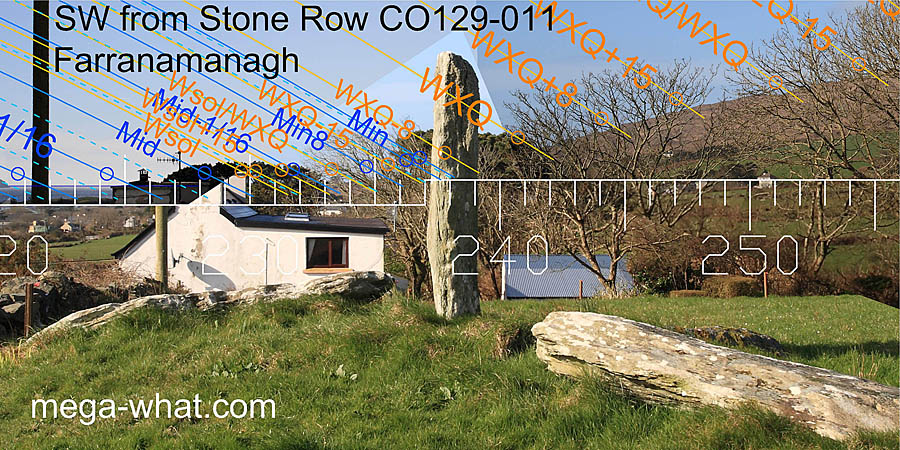 Farranamanagh Stone Row
Farranamanagh Stone Row:
Only one stone is upright. It indicates summer solstice / lunar mid-cycle to the north-east, minor standstill / winter cross-quarters to the south-west.

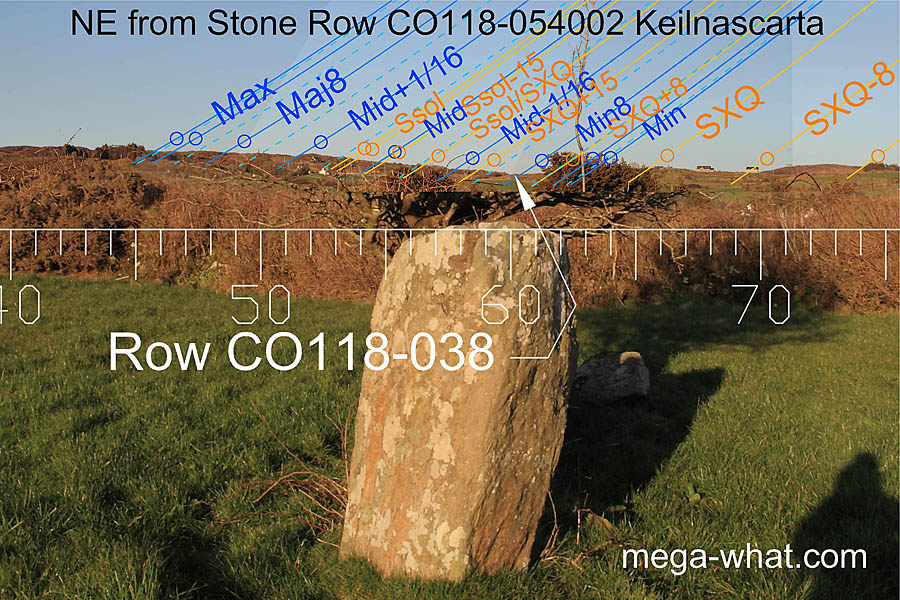 Keilnascarta Stone Row
Keilnascarta Stone Row:
The primary axis indicates minor standstill to the south-west.
The large south-west stone and fallen north-east one make accurate assessment of the axial reverse impossible but it indicates the minor half of the lunistice range.
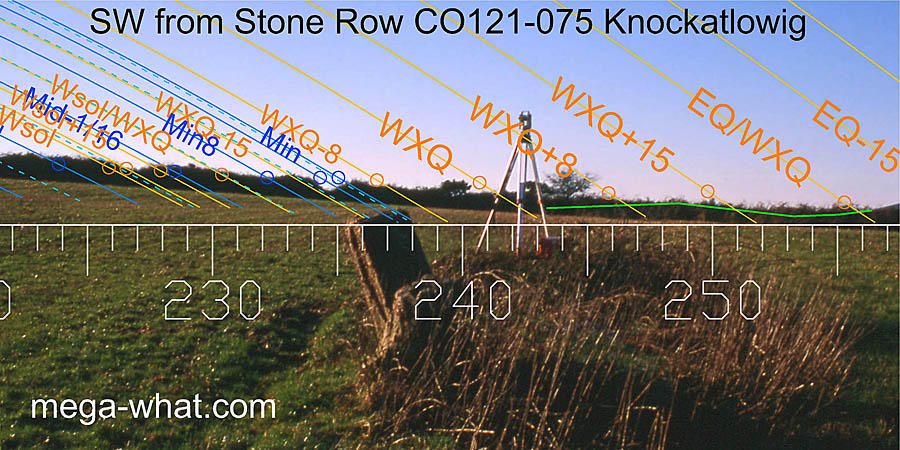
 Knockatlowig Stone Row
Knockatlowig Stone Row:
The tallest, south-west, stone is fallen and the other two are leaning but the axis was perhaps into the space between minor standstill and the winter cross-quarters.
North-eastwards, the reverse is towards the middle of the minor half of the lunistice range.

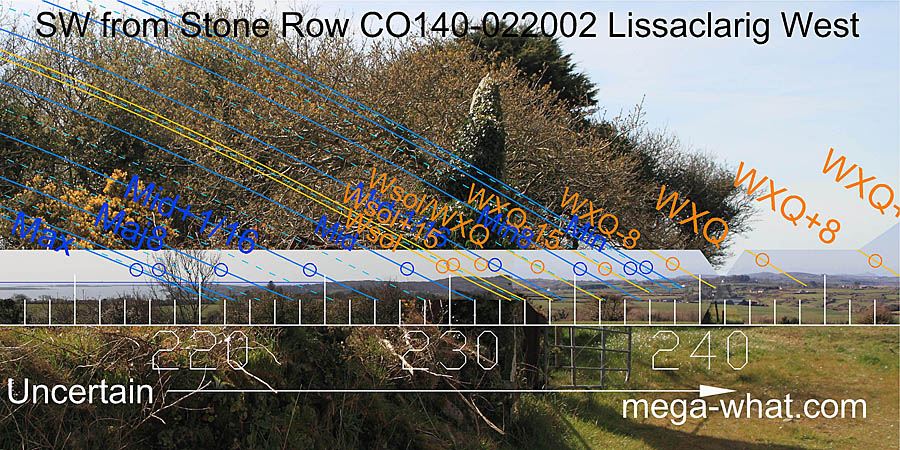 Lissaclarig Stone Row
Lissaclarig Stone Row:
The north-east stone is fallen and the western axial view is obscured.
To the north-east the axis occupies the space between minor standstill and the solstice / cross-quarter midpoint.
To the south-west it seems to mark the month centred on winter solstice.
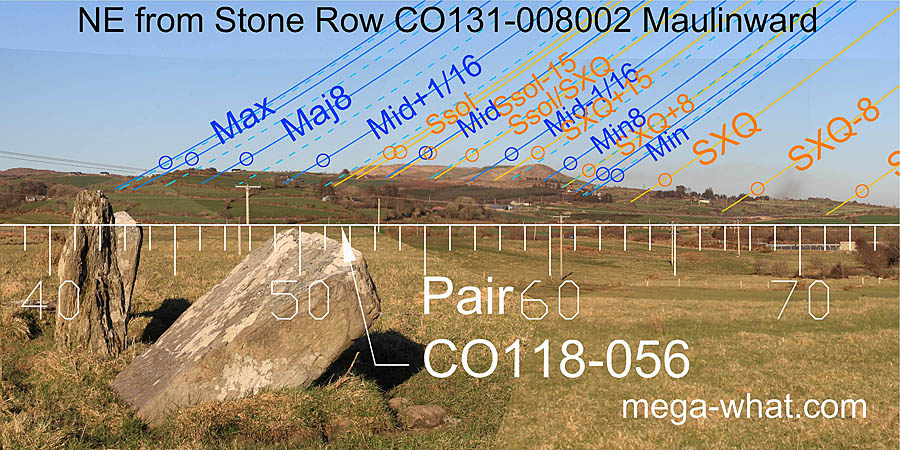
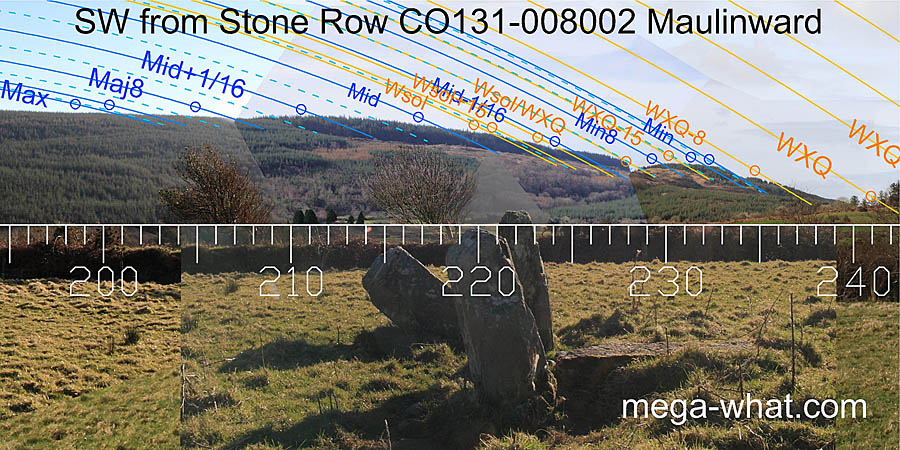 Maulinward Stone Row
Maulinward Stone Row:
The north-eastern axial line is just beyond major standstill.
The south-western axis seems intended to indicate winter solstice but the stones all lean too much to be sure.
Class = Lunar: Total 8 = 36%.
Both directions indicate a pure lunar zone (major side of the
lunistice
Lunistices are the most northerly and southerly moons of the month. The lunar equivalent of solstices. More.
range) or one direction does so while the other is beyond the entire luni-solar range.
Go to class= Solar |
Solar/Lunar
This first one is verging on the Solar / Lunar.
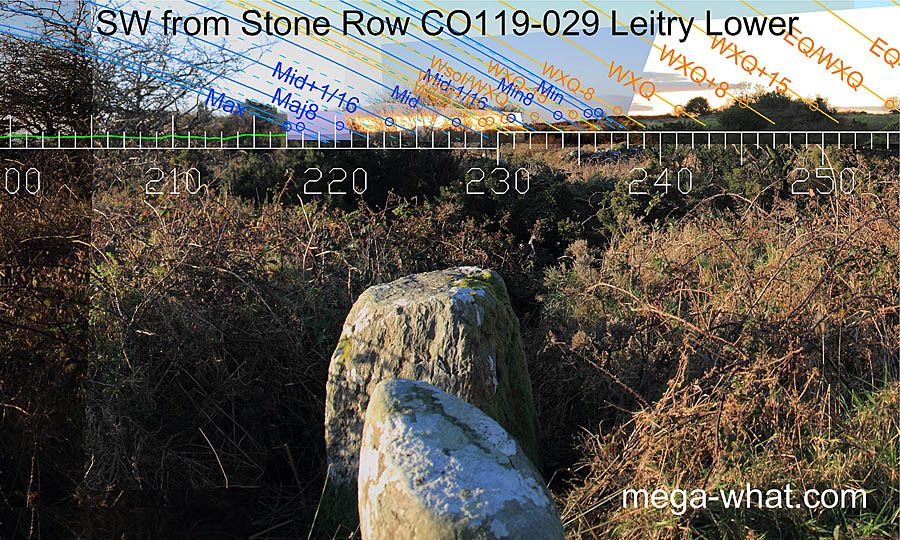
 Leitry Lower Stone Row:
The south-western axis seems to be towards the centre of the lunistice range.
The north-eastern stone, the same height as the SW one, is leaning badly and cannot be seen here but the axis in that direction is perhaps towards the lunar major eighth.
Leitry Lower Stone Row:
The south-western axis seems to be towards the centre of the lunistice range.
The north-eastern stone, the same height as the SW one, is leaning badly and cannot be seen here but the axis in that direction is perhaps towards the lunar major eighth.
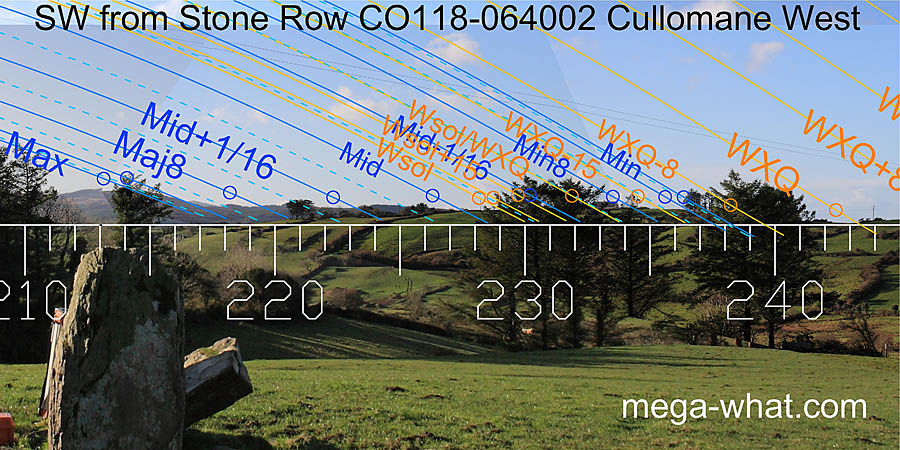
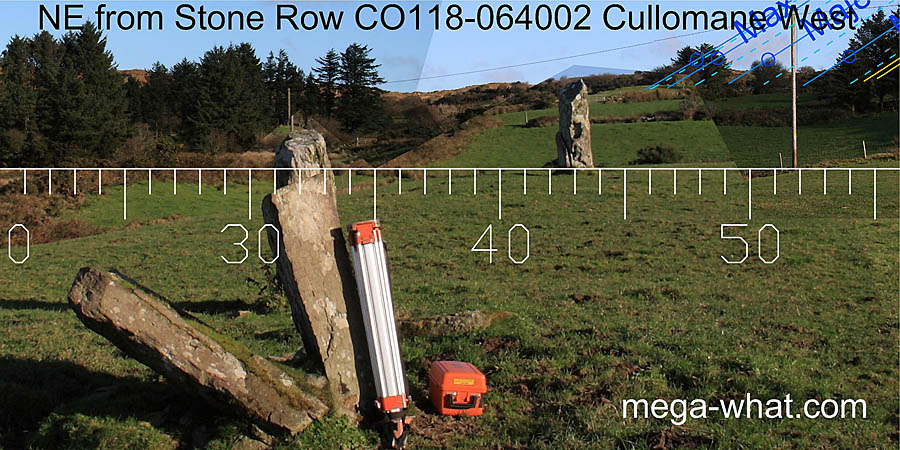 Cullomane Stone Row
Cullomane Stone Row:
This axis indicates major standstill to the south-west but is well beyond it to the north-east.

 Farrannahineeny Stone Row
Farrannahineeny Stone Row:
This five stone row indicates major standstill in both directions but greater subtleties may have been possible to the south-west.
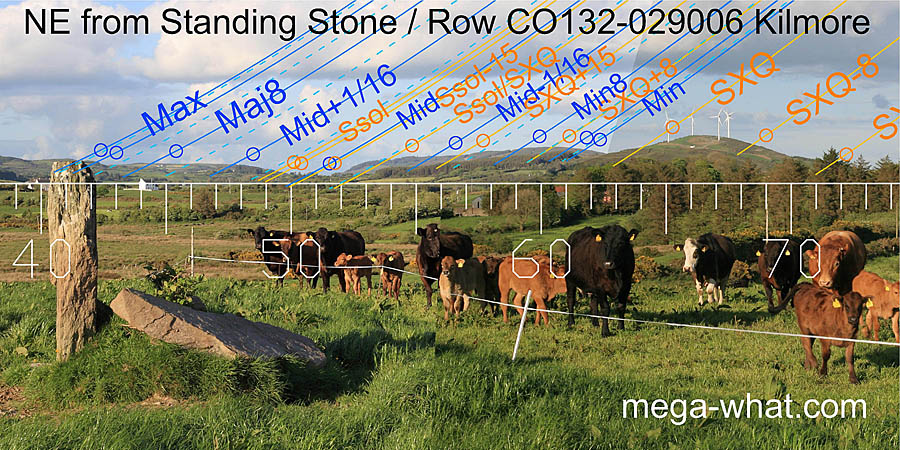
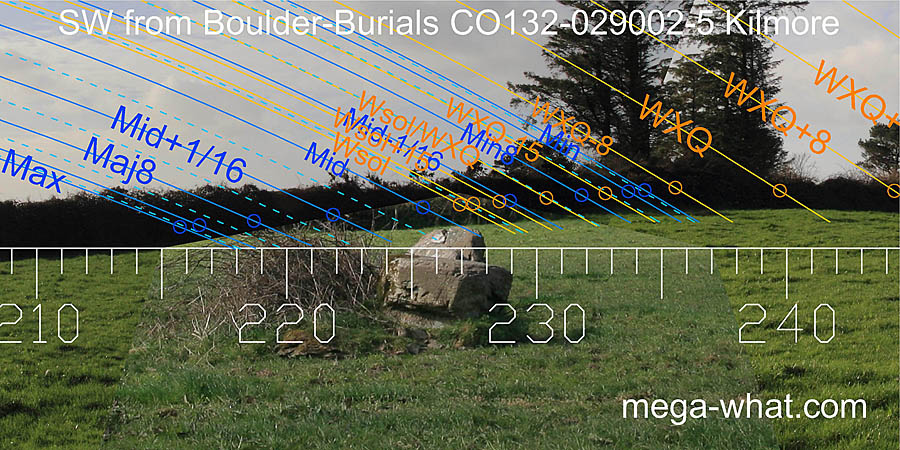 Kilmore Stone Row
Kilmore Stone Row:
Listed as a standing stone as it was buried in a bank when catalogued.
The one stone that was visible then remains upright and indicates major standstill to the north-east.
The south-west axis (c.221°) was not surveyed but the view would be almost identical to that from the adjacent boulder-burials.
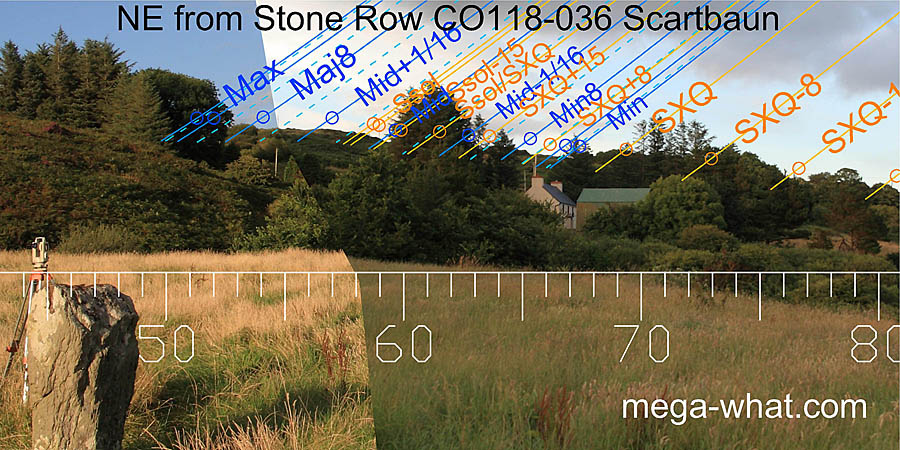
 Scartbaun Stone Row
Scartbaun Stone Row:
Axial reverse is beyond the north-eastern major standstill.
The south-western axis indicates the middle of the major half of the lunistice range.
The intention was clearly lunar but these last two could be classed as extreme.
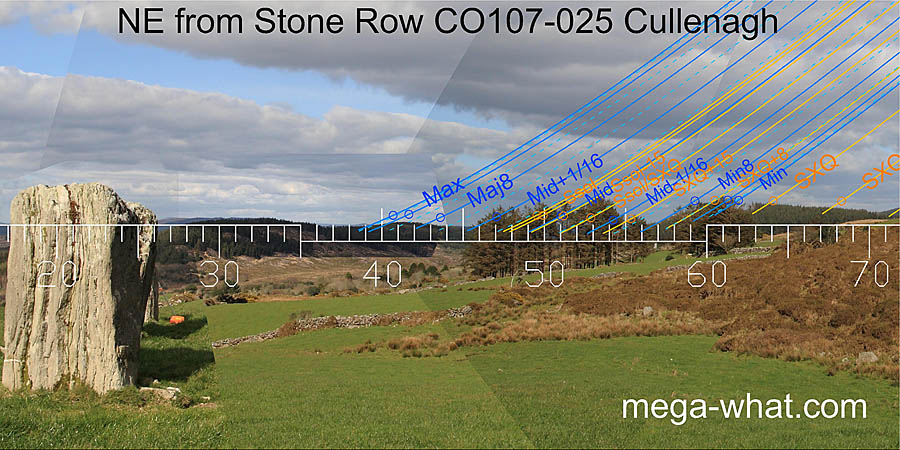
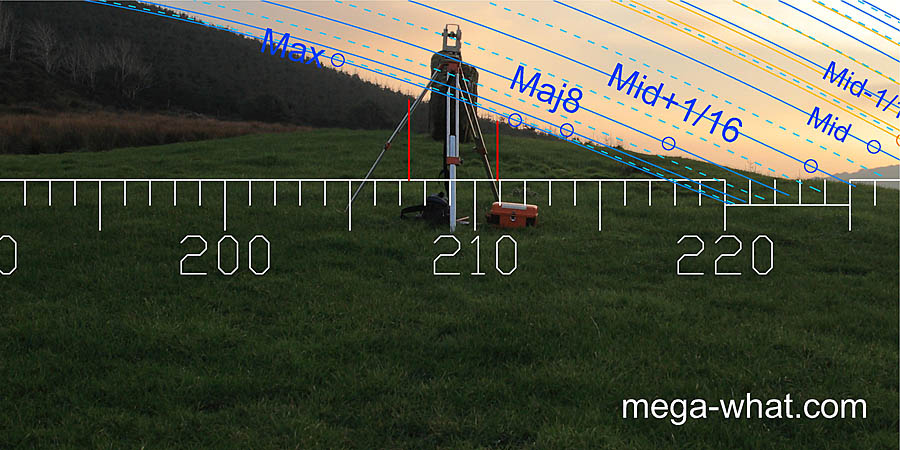 Cullenagh Stone Row
Cullenagh Stone Row:
Built at the eastern side of the top of a rise.
The north-eastern reverse axis is well beyond the major standstill.
To the south-west, the slope allows fine precision for major standstills.
© Michael Wilson.





